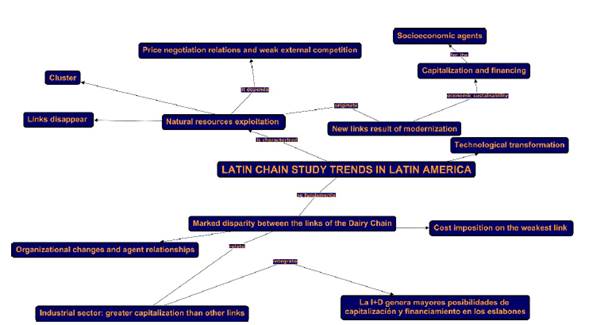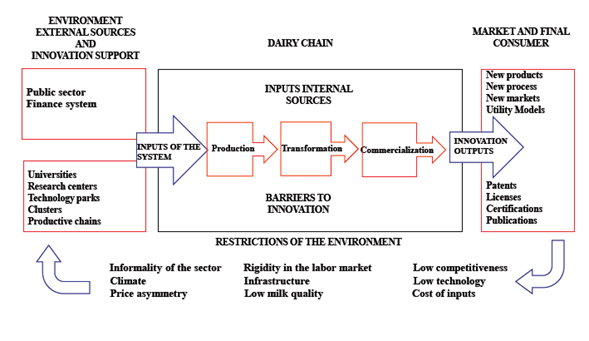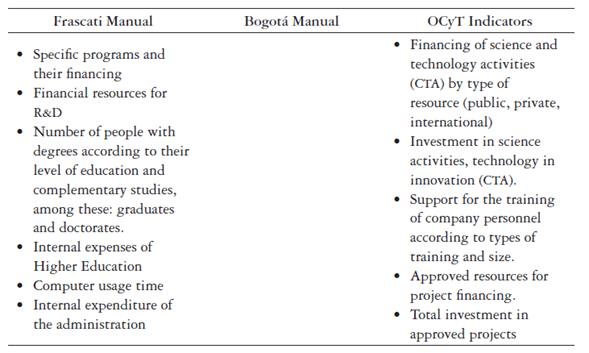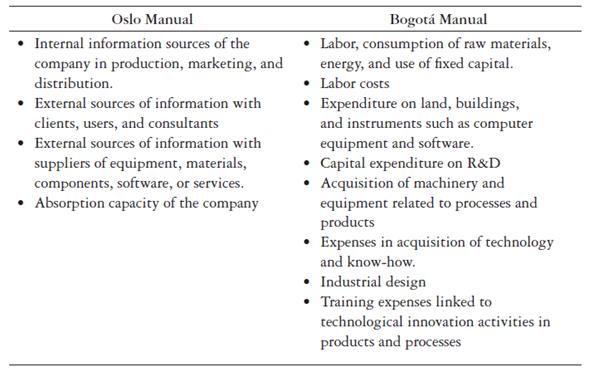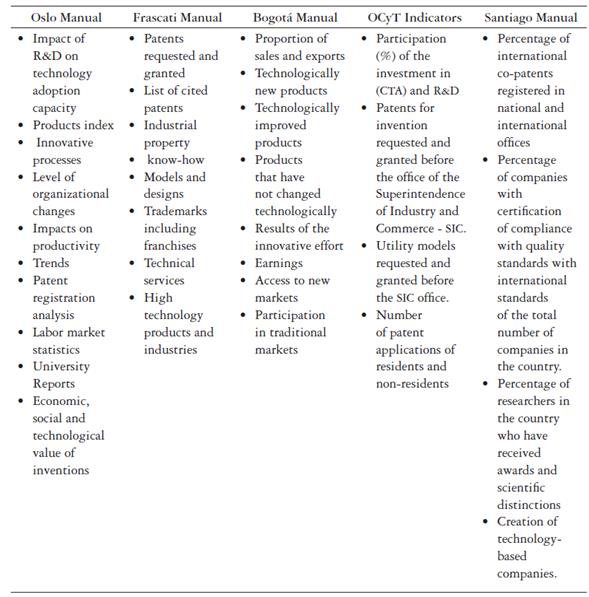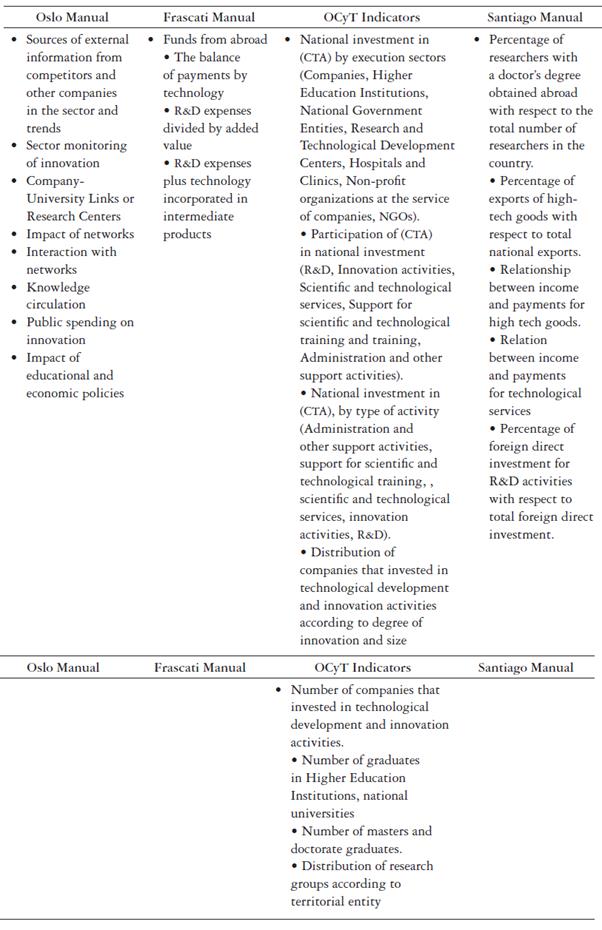1. INTRODUCTION
The dairy chain that integrates different organizations in three tiers: producer, distributor, and marketer, shows a disarticulation between its links, reflected in high production costs, informality, and low productivity and quality of products, that affects the generation of value and the competitiveness of the sector. The organizations in this chain associate innovation with risks, but do not see in it opportunities to be competitive and access new markets. Furthermore, there are no appropriate internal conditions to develop the market, nor focused public policies that effectively promote the development and diffusion of innovation throughout the chain. In this context, the question of how innovation can be promoted, in order to make the dairy chain in Latin America more competitive, arises. In this context, this paper aims to propose an innovation ecosystem in accordance with the characteristics of the dairy chain in the Latin American context. In this sense, the research is based on a descriptive study, based on the review of the existing literature on innovation, to relate it to the rural context, in order to conceptualize and highlight the most relevant aspects that help identify the main trends in the study of innovation in the dairy chain in Latin America, as well as approaching the identification of the main sources and barriers associated with innovation in the productive units of the dairy chain. These elements will be complemented with an analysis of documents referring to the measurement of innovation and R&D, to identify the activities and elements that support a proposal for the innovation ecosystem model for the dairy chain in Latin America.
This article is structured as follows: In the first part, the theoretical foundation that supports the innovation ecosystem proposal is presented. The second part explains the methodological design that supports the research; later, in the third part, the results of the investigation are presented; and, to finish, in the fourth part, a discussion of the results is carried out, and the main conclusions of the investigation are exposed.
2. ANALYTICAL FRAMEWORK
A review of the literature, which supports the proposal of an innovation ecosystem of the dairy chain, is presented below.
2.1. Systemic Approach. Its Contribution to the Configuration of Innovation Ecosystems
Biologist Ludwig Von Bertalanffy, in 1956, presented the fundamentals of systems theory, in which a system is conceived as a set of interacting elements (Domínguez and López, 2017). According to Ludwig, the systemic approach is based on three principles: the systems are composed subsystems that, in turn, are parts of suprasystems; the systems are open, and each system generates a continuous change of information and energy with its environment; and, finally, the systems have an objective and purpose (Bentoglio, 1993), when defining a role, it interacts with other systems that work in a medium environment, the structure that is constituted in the system will determine its functions (Domínguez and López, 2017).
All systems operate under the following parameters: a) Input, which constitutes the starting point, or inputs that provide the system with information or material to initiate, b) Throughput, processing or transformation that seeks to generate a result by transforming an input into output, c) Output, results of the system's relations in coherence with its objective, and d) Feedback, which purpose is the response of the system to the other elements that make it up, and its environment. It is important to mention that each system has restrictions that are the result of limitations in accessing its own resources.
From a systemic approach, Lundvall (1992) conceives technology as an accumulation of knowledge, generated and disseminated by companies, that innovate within an interactive system of internal learning, and with other companies, organizations, or agents. It is these changes, mechanisms and interactive learning processes of companies, which introduce innovations in a more complex system that integrates other agents, known as the National Innovation System (NIS). The NIS approach is based on different research carried out since the late eighties, as a framework to study the economic performance of countries from a historical and holistic perspective (Edquist, 2005).
The (NIS) have been created to facilitate the innovation process, improve competitiveness rates, and generally contribute to the development of countries and regions. This is possible thanks to the interaction between different agents that compose it (COTEC, 2004a): a) the public administrations are responsible for regulating the market, defining scientific, technological, and innovation policies, which contribute to generating a financial and legislative environment conducive to promoting innovation in companies. b) The public R&D system fulfills the function of promoting mobility, dissemination of science, and bolstering the relationships among support organizations for innovation (technology parks, universities, and research centers), which develop and transfer knowledge and technology to companies.
The notion of NIS has also transcended the regional environment (Ondategui, 2004). Authors such as Lundvall (1992), Koschatzky (1998), and Asheim and Cooke (1998) have studied Regional Innovation Systems (RIS), observing how industries tend to concentrate on specific regions, and the existence of decentralized policies whose framework of application are the regions (Porter, 1990). Today, the concept of RIS is related to the so-called innovation ecosystems.
A new form of RIS is the innovation ecosystems. Adner (2006, 2010) is the seminal author of this systemic vision of innovation, in which he proposes a contingent and holistic model called the innovation ecosystem, characterized by the configuration of activities, necessary actors, positions, and links, that, through their interaction. allow for the transfer of information, knowledge, and technology throughout the entire value chain, facilitating the development, implementation, and adoption of innovations (Adner, 2017). Therefore, the success of companies depends largely on their ability to understand that innovation is present throughout the value chain, and that their analysis can help them develop a more appropriate innovation strategy (Rincon-D and Diaz-M, 2016).
Currently, the importance of innovation ecosystems for academia and for governments is recognized. However, it is imperative to clarify, for the purposes of this research work, where the concept of innovation ecosystem comes from. Some authors, such as Vasconcelos et al. (2018); and Scaringella & Radziwon (2018), have carried out a literature review through bibliometric studies, and identified that the concept of innovation ecosystem is related to other important issues of innovation and competitiveness beyond the approaches of the evolutionary economy of Nelson & Winter (1982) and Dosi (1982), and of strategic management of Porter (1985) and Barney (1991).
In this context, according to Vasconcelos et al. (2018) and Scaringella & Radziwon (2018), innovation ecosystems are related to the studies of the industrial organization (Williamson, 1975; Hughes, 1983), and more closely to business ecosystems (Teece, 1986; Moore, 1996, 2006; Iansiti & Levinen, 2004b), knowledge ecosystems (Van der Borgh et al., 2012; Clarysse et al., 2014) and entrepreneurial ecosystems (Parahald et al., 2005; Isenberg, 2010). All these ecosystem forms have in common the interaction of various agents, as Adner (2017) mentions, in which such interaction requires the dynamics of innovation.
2.2. Innovation Measurement. Input, Output, and System Indicators
In order to measure R&D, the OECD proposed, in 1963, the creation of the Frascati Manual, to provide guidelines for the measurement of basic, applied, and experimental research. Subsequently, at the beginning of the decade of the year 2000, the Oslo Manual was created, in order to collect and interpret data on innovation and technology (Innovative types and activities - innovative companies). These manuals, over the years, have become a tool for countries, to create public policies, through an institutional framework, that support innovation systems, consisting of private research networks, universities, financial system, public system, and other companies, which are in constant interaction.
Considering that the Frascati and Oslo Manuals were created for industrialized and innovative countries, new versions have emerged, adapted to the conditions ofunderdeveloped countries. Within these manuals, there are some examples such as: Manual de Bogotá (2001) and Manual de Santiago (2007). With a similar objective, the Colombian Observatory of Science and Technology (OCyT), since 2007, has been building indicators to measure the progress of science, technology, and innovation in Colombia. As mentioned in section 2.1, all systems are governed by the parameters of Input, Throughput, Output, and Feedback. The aforementioned manuals give the guidelines to measure R & D & I, both for organizations, as well as in the relationship with their environment or the system of which they are part, through Input, Output, and system indicators. These indicators will support the innovation ecosystem proposal for the dairy chain.
2.3. Sources and Barriers to Innovation
2.3.1. Sources of Innovation
According to Rincon-D and Diaz-M (2016), innovation and entrepre-neurship are two concepts mediated by the capacity and propensity of a person or organization in the generation of value, through the materialization of an idea with innovative features, that allows meeting new needs in the market. For this, Drucker (2008, p. 3) proposes that the adoption of innovations is related to a series of internal and external sources, through which organizations can identify and exploit their innovative potentials in the future.
In Table 1, internal sources of innovation are identified: unexpected events, inconsistencies arising from what is expected and what is obtained between the economy, the industry, the preferences and expectations of customers (Drucker, 2008), that is, the actions of the organization respond to the dynamism of all interest groups and economic, political, and social forces of the macro environment. Other internal factors respond to the needs of new processes related to the development of innovations that will be viable when the organization can identify a need and have the necessary knowledge and work capacity to carry it out. Finally, an organization can take advantage of the constant changes in the structure of the industry and the market with rapid growth, making technological convergence, and creating new businesses. On the other hand, demographic changes, changes in perception, and new knowledge must be exploited by the organization through market segmentation; thus, identifying sources of external innovation, in order to understand the perception of its customers, and to adapt to new knowledge and technologies.
2.3.2. Barriers to Innovation
Innovation is an important source for the development of competitive advantages in organizations (Porter, 1990). However, the uncertainty and high costs associated with the innovative process represent important barriers for organizations when they want to invest in R & D & I (Silva and Ramírez, 2006). In this sense, every process of organizational change leads to uncertainty (Miguel et al., 2003). That is why organizations generally present a series of barriers that limit their ability to absorb knowledge and technology from the environment (Molina-Moráles and Mas-Verdú, 2008; Barge-Gil et al., 2011a). Some of these barriers are related to:
Financial barriers related to the cost of research that organizations must pay (Silva and Ramírez, 2006; Astrom et al., 2008; Moñux, Aleixandre, Gómez, and Miguel, 2003).
The lack of an innovative culture in organizations (Astrom et al. 2008; Olazaran, Roessl, Kesler, and Fink, 2010).
The perception of risk that organizations have when they want to invest in R + D + I. (Astrom et al., 2008; Lyne, 2007; Mas-Verdú, Bavaria, Puig, and Martínez-Gómez, 2008; Roessl et al., 2010).
The low capacity of organizations to absorb knowledge and technology (Cohen and Levinthal, 1990; Zahra and George, 2002).
In order for organizations to overcome these barriers, they must strengthen their internal capacities, and interact effectively with other innovation, promoting agents in their environment such as universities, research centers, technology parks, technology transfer offices, and other companies in their sector (Rincon-D and Diaz-M, 2016).
2.4. Value Chain
Territories should specialize in economic activities that, depending on their resources, represent less costs and greater advantages in economies of scale (Krugman et al.; 2012). Under this neoclassical view, different investigations (Hirschman, 1958; Porter, 1985; Krugman, 1999; Kaplinsky and Morris, 2000) have stated that in order to understand the dynamics of economic exploitation of the territories, the interactions between different elements or links must be studied. They are determinants for the creation of value (Rincon-D and Diaz-M, 2016).
For Porter (1985), the value chain allows studying the links of an economic activity that operate in a disaggregated manner, and the strategies that it can adopt to align the activities, so that it can maximize its effect on these links, with profit maximizing results. The value chain is a system of interdependent activities that are integrated thanks to these links, which are the relationships between the way in which one activity is performed, and the cost or performance of another; in turn, they contribute to the competitive advantage in two ways: first, optimization, in which the links reflect the exchanges between the activities to achieve the same overall result, meaning that an organization must optimize those links to reflect the strategy, and reach its competitive advantage; and, secondly, the coordination of activities within the processes, which helps reduce costs and increase differentiation (Rincon-D and Diaz-M, 2016).
The value chain of an organization is a part of a larger value system, in which the different value chains of suppliers, distribution channels, the final buyer, and the organization are integrated and interact, in many cases, determining the way in which this can be managed efficiently, both economically and socially. Consequently, obtaining and maintaining the competitive advantage will depend not only on understanding the value chain of an organization, but how the organization fits into the overall value system of a value chain (Rincon-D and Diaz-M, 2016).
2.5. Dairy Chain
2.5.1 Latin American Context
The globalization has brought about a substantial change in the dairy chain since the economic opening in Latin America, therefore, it has changed the perspective of a production aimed at satisfying domestic demand, without quality controls or applied added value, without providing surpluses of production for immediate export, as well as the entry of agents with sufficient production capacity and optimum quality levels. Consequently, the Latin American countries that most influence the dairy sector are Brazil, Mexico, Uruguay, Chile, and Argentina, which have adapted policies and/or standards for process improvement and are cohesive, to a greater or lesser extent, in the links and cluster of the dairy chain, to maintain stable levels of competitiveness (OCLA, 2020).
This phenomenon has been affecting the dairy processing industry for several years, due to the influence of the commercial opening and new practices in the dairy market of new competitors, especially the large stores and hypermarkets that market their own brands and are also diversifying their milk products to attract a greater number of consumers, for example, people who take care of their health or are lactose intolerant. These practices exert pressure on suppliers or small producers, through price, which must be renegotiated with large companies, transferring additional costs to small producers in the first link of the dairy chain, which affects their ability to invest in the technification of its processes and does not allow them to take advantage of opportunities to improve their companies and their living conditions (Alvarez, Herrera, Alonso, & Barreras, 2012).
It is important to mention that the Latin American model is characterized by supporting its economies in the exploitation of primary products. The appearance in recent years of productive complexes or clusters for the dairy sector that work around milk production, its industrialization, and commercialization are changing the dynamics of the sector. Clusters can help boost the sector by allowing small producers to access new technology to improve their market position (Gereffi, G. 2019), through interaction with other organizations that are part of the dairy
chain. However, unlike developed countries, in Latin America, clusters do not always bring advantages for small producers that are characterized by being highly informal organizations with artisanal production. It is a very important part of the industry, and its history, living conditions, and culture must be taken into account.
2.5.2. Dairy Chain in Colombia
In Colombia, the dairy chain is traditionally composed of three links: milk production, dairy processing, and distribution-marketing, which are coupled to each other, generating added value to the product throughout the chain until it reaches the final consumer. However, in the CONPES 3676 document (DNP, 2010), the value chain defines six links: input suppliers, production systems, collection centers, processing plants, marketers, and consumers (Rincon-D and Diaz-M, 2016).
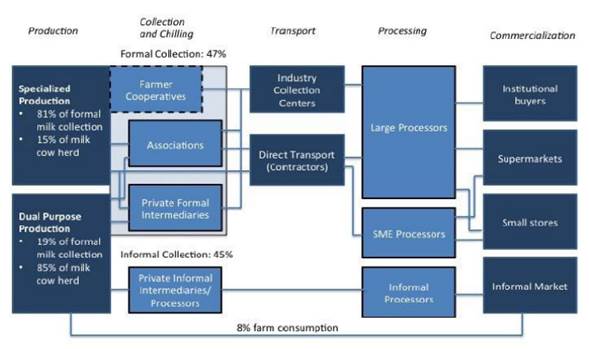
Source: Nino and Alarcon (2015), FEDEGAN (2013) in World Bank Group (2018) p, 20
Figure 1 The dairy chain in Colombia
The national production of fresh milk in Colombia during the last 50 years of the 20th century showed a progressive increase, going from 728 million liters in 1950 to 1,879 million liters in 1978, and, later, 5,326 million liters in 1997 (Ministerio de Agricultura y Desarrollo Rural e Instituto Interamericano de Cooperación para la Agricultura- IICA, 1999, p. 10). This trend in production has continued for the last 20 years, reaching a production of 7,094 million liters in 20182.
It is important to mention that, unlike other milk producing countries, where the increase in animals per hectare is reflected in an increase in production and a reduction in production costs, the trend in Colombia according to the Consejo Nacional Lácteo (2011, p. 1) is framed in a constant variation of milk production costs per hectare, therefore, in Colombia, the area of the milk producing unit is inversely related to productivity, measured in liters produced per hectare per year. This phenomenon is present in Colombian regions such as Antioquia, where the inputs related to milking activity represent 79% of production costs, while in other milk-producing regions, such as Nariño and Cundinamarca, it is the labor force that has the highest, approximately 50% share of the production costs (Aktivia, 2013, p. 3).
2.5.3. New Environmental Challenges and Consumer Trends in the Dairy Sector
The needs of new sustainability scenarios in the dairy sector have promoted ecological livestock, with native or local breeds, where it guarantees mitigation and adaptation to climate change, in accordance to the increase in world demand; as an example, in the learning curve, the case of the Dutch dairy sector can be mentioned as a white engine that focuses on: development towards climate neutrality, improvements in animal health and welfare, preservation of grazing, and protection of biodiversity and the environment (Zwister & Saraza, 2016). Thus, these measures allow for the improvement of waste and waste technologies, so that they can be incorporated into the dairy chain (Antolínez, 2020).
In Colombia, progress is being made in promoting the competitiveness of the agroindustrial sector, thus contributing to business development; science, technology and innovation; infrastructure and connectivity, internationalization, and the development of human talent for this sector. (López, & Morales, 2020). However, price volatility is due to a complex set of factors, many of them outside the control of the dairy sector itself, according to Minagricultura, (2020). In recent years, payment to the producers has decreased, while the consumer, who currently demands a diversified supply of healthy dairy products and has new characteristics that respond to a healthier lifestyle, must be willing to pay higher prices for said products, which is contrary to the consumption of dairy products in developed countries, where the supply of dairy products is higher and its price is comparatively lower than in the Colombian market. In addition, there is still a significant lag compared to the productivity of this sector, where there are still problems of gaps between small and large producers, low technology, inefficient use of land, and social problems in the producing communities of the first link of the dairy chain.
Consequently, these changes require transformations from innovation and research, not only in product innovation, but also in context innovation, for both the supply and demand of dairy goods and services. To improve this sector, it is necessary to integrate the different agents of the innovation ecosystem, which should promote, participate, and encourage the implementation of sustainable strategies, which help organizations in this sector to integrate their quality and environmental costs and with this, business management in the dairy industry and business sustainability can be enhanced (Abigail, Isela & Saulo, 2020). In this context, it is essential to propose an innovation ecosystem for the dairy sector.
3. METHODOLOGICAL DESIGN
This article is the result of the first phase of a research project entitled "Innovation and Energy in the Productive Units of the Dairy Chain". The results presented in this document are based on a descriptive study that seeks to propose an innovation ecosystem in accordance with the characteristics of the dairy chain in the Latin American context.
Initially, a literature search on research trends in the dairy chain in Latin America was carried out, with the purpose of establishing if there are initiatives or policies focused on the development of ecosystems for this sector in Latin American countries. Subsequently, an analysis of some research in the dairy sector is undertaken, to identify which of the sources and barriers associated with innovation are present in this sector, and which may be determining factors in the proper functioning of the soon- to-be-proposed ecosystem. Finally, based on the theoretical fundament on innovation ecosystems and the analysis of documents related to innovation and R&D, such as the manuals of Frascati (2015), Oslo (2018), Bogotá (2001), and the reports of the Colombian Observatory of Science and Technology OCyT (2018), the input, output and system parameters, their main activities and indicators, as well the different agents whish integrate the proposal for an innovation ecosystem for the dairy sector, have been identified.
4. RESULTS
4.1. The main research results are presented below. Trends in the Study of the Dairy Chain in Latin America
Once the literature search was done, the main trends in the study of the dairy chain in Latin America were identified. Figure No. 2 presents an outline of the study trends at the Latin American level, related to the Dairy chain.
According to the literature consulted worldwide, milk production is one of the activities that allows obtaining income in the short term, and, in turn, contributes to the generation of a significant number of jobs. This activity, in developed countries, has a greater use of technology and less use of labor, in developing countries, on the contrary, the process is not yet fully technified, so the use of manufacturing is necessary. This difference is due to the fact that, in developed countries, there is an intensive agriculture, based on the exploitation of the land and the intensive use of the means of production through technology, while in developing countries agriculture is extensive, due to to the availability and use of large areas and natural resources. In recent years, Latin American countries have increased their participation in world milk production. This growth trend is mainly due to the increase in the number of animals destined for production, and not to the productivity of each animal, generating profitability by volume, and not as a unit (see figure No 2).
Another trend in the study of the dairy sector in Latin America is related to the configuration of associative processes and government participation in the creation of value in the dairy chain. Each country, in accordance with its economic, labor, and environmental policies, encourages, to a greater or lesser extent, the competitiveness and association of the participants in the dairy chain. Sometimes it is horizontal, where the actors belonging to the same link compete and associate with each other, and sometimes the integration is vertical, when the agents of the different links come together and manage to unify or act according to the needs that each one has.
Finally, the trend of the dairy chain studies related to innovation and development highlight that innovation is a dynamic process of interaction that unites agents who work guided by market incentives (such as companies), and other institutions (such as public research centers and academic institutions) that act according to strategies that respond to other mechanisms and incentive schemes that promote marketing, technical improvements, and association between different actors in the dairy chain to make it more sustainable.
4.2. Results of the Analysis of the Literature on the Dairy Chain Related to the Sources and Barriers of Innovation
With the purpose of knowing some of the factors that are driving innovation, or that represent obstacles to it in the dairy chain in Latin America, some examples of the research related to sources and barriers of innovation in the dairy chain mentioned in section 2.3 are presented below.
• Unexpected events, based on possible successes or failures
The research of Echeverri, Galeano-Vasco, Cerón-Muñoz, and Márquez (2015) on the evaluation of the impacts of temperature and humidity on milk production, testing smoothed functions of these variables in the hours prior to milking.
• Inconsistencies arising from what is expected and what is obtained
While it is true that the milk production link generates a significant level of employment in the country, extensive and easily accessible training programs are required to improve the levels of skilled labor in the country. Likewise, in the dairy chain, technological improvements have been taking place, mainly in the industrial link, and the technification of areas suitable for milk production must be directed with clear goals (Quintero, 2012).
• Need for processes and requirements to make them viable
The parameters of hygienic and sanitary quality in the regions of high milk production in Colombia have improved by meeting the standards required by the norm at the national and international levels, respectively: and there is great potential in the area to exceed international standards, even when the vast majority of these productions are developed in pastoral systems (Cerón, Gutiérrez, Bolivar, Bedoya and Palacio, 2015).
• Changes in the structure of the sector or in the structure of the market
One of the great advantages of livestock farming in the low tropics is its proximity to major cities to have good access roads, which makes it easier for the product to reach the market, allowing the producer to get better dividends for their goods (Castrillón, 2013). The development of the associativity in small and medium producers offers a greater volume and better quality of the delivered milk, which gives them negotiating power against the dairy industry (Calderón, Jiménez & García, 2008).
• Demographics
Economic and social progress associates greater consumption of natural resources and structural change in the economy; the dynamics of use and quantity of freshwater in the biosphere are in conflict with anthropocentric pressure, showing a scale of scarcity of the natural resource, not only from the perspective of economic value, but also of social value that affects the possibilities of improvement in the economic and social dimension (Clavijo, Vera and Fandiño, 2012; UNESCO, 2015).
• Changes in perception
The conceptual relationship associating the rural with agricultural and livestock activities of an artisanal nature without greater added value. However, the dynamics of a rural economy go beyond only agricultural and livestock goods: to the provision of rural services based on environmental, recreational, and tourist services (Rojas, 2008; Rosas-Baño, 2013; Kay, 2009). Consequently, globalization puts pressure on the interpretation of the new rurality in Latin America, due to the heterogeneous sense in its perception of territory and of the different historical events, linking diversity of activities and social relations between the rural and urban, without a sectoral division (Romero et al., 2013).
• New knowledge
Collaboration with research centres, universities, the state, and workers is increasing, taking into account the synergy with all links in the dairy chain; from technological developments in incoming milk with hygieni-sation, pasteurisation, and standardisation processes, to monitoring the health of cows and the quality of the milk (Marotta, Mark, Blom & Thorn, 2007; Sossa, Valencia, Vasco & Copete, 2012; Cavieles & Ramírez, 2012).
• The innovative culture
It can be inferred that the knowledge of the degree of competitiveness along the dairy chain can become a tool for administrative decisions, where the quality of milk is enhanced to allow the development of a high industrial potential, obtaining diversification of products in their different varieties, and reduction in operational costs (Portilla, et. al., 2011; Barrios & Olivera, 2013).
• Perception of the risk to be invested in R&D
Livestock farming under specialized dairy conditions has significant environmental burdens and additional production costs, so it is necessary to identify mitigation alternatives in areas such as enteric fermentation, chemical nitrogen fertilization, and the manufacture of concentrated feed. Among the emission reduction alternatives to be implemented to reduce emissions, those related to improving productivity, making more efficient use of feed concentrates and improving fertilization, could be considered (Rivera, Arenas, Rivera, Benavides, Sánchez, and Barahona, 2014).
• Knowledge and technology absorption capacity
Recent changes in the agricultural production model, in terms of land use, technological innovation, and productive efficiency as management logic, are key factors that influence the subjective construction of climate variability (Riera & Pereira, 2013).
In Latin America, the main tropical dairy breeds found were the Central American Criollo Dairy, Doran, Lemon, Costeño con Cuernos (CCC), and Blanco Oreginegro (BON). These have certain phenotypical and genotypical characteristics to be considered as an alternative for milk production in the tropics. However, the focus of studies, the scarcity of informa tion such as inventories, location, and characteristics, as well as schemes for dissemination and their disclosure, have limited its distribution (Vilaboa, Diaz, Wingching, and Zetina, 2013).
• Financial barriers
The existence of a gap in economic profitability in small milk production units, as there are very few productive units with the means to acquire new technology and, thus, receiving an income greater than the joint value of labor, natural resources, inputs, and technology used in the generation of dairy products (Romo et al., 2014).
4.3. Proposal for an Innovation Ecosystem Model for the Dairy Chain
As a result of the analysis of the literature, the following innovation ecosystem for the dairy chain is proposed (see figure No. 3).
The proposed innovation ecosystem presents a scenario in which the organizations of the dairy chain that make up the three links: producers, processors and marketers, can be innovative through interaction with other agents in the ecosystem.
On one hand, the external sources that support innovation organizations in the dairy chain must relate to projects with universities, research centers, clusters, and chains. The success of these relationships with those who provide some inputs necessary for the revitalization of the dairy chain depends largely on the support provided by the public and financial sector. The external inputs entering the dairy chain are complemented by internal sources, result of the needs of the activity of these organizations to focus on improving processes, and technology acquisition, among others. It is expected that the organizations of the three links are interacting, sharing information and resources with each other, allowing them to generate higher outputs of innovation, to overcome barriers, and to better cope with restrictions in the environment of this sector, characterized by informality, price asymmetry, weather, industry regulations, and market conditions, among others (see figure 3).
The variables that make up the ecosystem proposal as mentioned, are supported by the input, output, and system parameters. The manuals of Frascati (2015), Oslo (2018), Santiago (2007), Bogotá (2001), and OCyT (2018) present indicators to measure innovation, and a series of activities related to these parameters, which must be developed in the interaction between the different agents that make up the innovation ecosystem, with the purpose of driving innovation through the dairy chain. Below, the selected indicators and activities that support the three system parameters that make up this ecosystem proposal are shown.
4.3.1. Input Indicators. External Sources that Support Innovation
A review of the manuals was made, and the main inputs from external sources that support innovation were found:
The three manuals cited in the Table No. 2 present some of the main inputs or activities focused on the allocation of financial resources for research, support, and strengthening from public administrations to companies.
4.3.2. Input indicators. Internal Sources of Organizations
In the manuals consulted, it was established that the Oslo (2018) manual and the Bogotá (2001) manual have more input indicators that organizations within the ecosystem must develop in order to be innovative and overcome innovation barriers (see table No. 3).
In the combination of external and internal sources, organizations must make investments and internal improvements, focused on the appropriation of technology, and on strengthening their human resources to be able to appropriate innovations and generate them. This must be a necessary step so that the organizations of the dairy ecosystem can better understand their market, who are their interest groups, and interact with organizations of the other links in the chain.
4.3.3. Output Indicators
Within an innovation ecosystem, it is expected that, as a result of the interaction between the agents of the model, the innovative potential of organizations will be greater. The five manuals consulted present some indicators of innovation outputs.
A significant number of innovation outputs are associated with technological advances, process improvements, new products and services developed and in the protection of new investments through patents. It is equally important to highlight other outputs, such as technology-based companies and recognition to researchers (See table No. 4).
4.3.4. System Indicators
Finally, some system indicators that support the proposed innovation ecosystem model were identified.
Some of the system indicators presented in Table 5 constitute inputs that guarantee resources and support to projects between system agents, while other indicators show results of the management of these agents, on which public policy should be formulated (see table No. 5).
5. DISCUSSION
In relation to the literature focused on the trends in innovation of the dairy chain in Latin America, it is important to highlight that both research and public policies are aimed at understanding the dynamics of the organizations that are part of this chain. On the one hand, government policies focus on improving the sector's competitiveness by promoting associativity, the creation of clusters and production chains, and on proposals for sector development plans (Gereffi, G. 2019). In this context, it is important to mention that the productive systems in the rural environment are essential elements in the agro-industrial models. In the case of Colombia, agro-industrial markets are subject to competitiveness problems in the face of more specialized and dynamic global food markets. This is partly due to the fact that there is still a disarticulation between the dairy sector and the territory, which makes it impossible to develop territorial capacities that allow improving sectorial competitiveness in the global market, as noted (Chacón, & Jolly, 2006, p. 316).
Research, for its part, has an interest in the development of capacities that promote the development and adoption of innovation in the organizations of the different links, especially those of the first link. Research and innovation activities in the food sector have allowed progress in competitiveness and productivity in the context of globalization, however, there is little progress in adopting a new model of sustainable development and preservation of natural resources that must lean on advances in science and technology for human and social development (Giraldo, 2011, p. 16).
Regarding the identification of internal sources of innovation (Drucker, 2008), in this sample of researchs in the Latin American sphere, it is interesting to see how these organizations are working to implement non-technological innovations (Echeverri et al., 2015) in response to some unexpected events, providing competencies and new capacities to the human resources of these organizations, related to inconsistencies compared to what is expected (Quintero, 2012), new processes to improve milk quality, and to respond to international standards resulting from own improvement needs (Cerón et al., 2015) or adaptations of organizations in this sector to the new conditions of the industry (Castrillón, 2013; Calderón et al., 2008).
Following this same scheme, the analysis of external sources of innovation (Drucker, 2008) for the dairy chain shows how these organizations are adapting to demographic changes in response to scarcity of natural resources (Clavijo et al., 2012; UNESCO, 2015), changing their perception of their business and its environment, seeking to complement agricultural activities with other demanded services, such as nature tourism (Rojas, 2008; Rosas-Baño, 2013; Kay, 2009) in a context of new rurality (Romero, et al ., 2013), and, something very important, starting to work and integrate with other agents of the innovation ecosystem, such as universities and research centers.
From the point of view of barriers to innovation, as other industries, organizations in the dairy sector face the same barriers associated with innovation. In the analysis of these barriers in the sample of researches cited, the lack of an innovative culture is clear (Astrom et al., 2008; Olazaran, Albizu, and Otero, 2009; Roessl, Kesler, and Fink, 2010) in these organizations due, in part, to high informality (Portilla, et al., 2011; Barrios & Olivera, 2013), a perception of risk (Astrom et al., 2008; Lyne, 2007; Mas-Verdú, Baviera, Puig, and Martínez-Gómez, 2008; Roessl et al., 2010) to invest in new technologies, processes and inputs that increase costs for producers (Rivera et al., 2014), or that represent other barriers such as low capacity to assimilate and appropriate technological innovations (Cohen and Levinthal, 1990; Zahra and George, 2002), or that are often not available to small milk producers because they do not have the resources (Romo et al., 2014) or do not know who can help them finance these innovations (Silva and Ramírez, 2006; Astrom et al., 2008; Moñux, Aleixandre, Gómez, and Miguel, 2003).
Regarding the innovation ecosystem proposal, the analysis of the literature on the dairy chain in Latin America shows an absence of mechanisms for capturing and analyzing homogeneous information concerning the system inputs necessary for its dynamisation: prices, production costs, yields, consumption, informality, quality of goods and services, among others; which would undoubtedly improve if there was a greater integration of the dairy chain with other agents of the ecosystem, government, universities, research centers, and others. This situation represents obstacles in the definition of appropriate competitiveness policies, which do not help the generation of value in the chain or allow overcoming the barriers and restrictions typical of this sector for dairy chain organizations, nor obtaining higher innovation outputs through the diversification of dairy products and derivatives, which is a little exploited market in the Latin American context (Giraldo, 2011, p. 54).
6. CONCLUSIONS
This article asks the question: How can innovation be promoted, in order to make the dairy chain in Latin America more competitive? To answer this question, the objective of the research was to propose an innovation ecosystem, in accordance with the characteristics of the dairy chain in the Latin American context. To do this, a descriptive study was carried out, based on an analysis of the literature on the dairy chain in the Latin American context, to identify the main study trends and perform a preliminary analysis of the sources and barriers associated with innovation. In addition, the study addressed the manuals from Oslo (2018), Frascati (2015), Bogotá (2001), Santiago (2007), and the OCyT (2018) to identify the indicators and associated activities that together allow us to propose an innovation ecosystem for the dairy chain.
Taking as a basis the theoretical positions, this model, which is supported by variables that constitute the external inputs of the system, internal inputs of the organizations, innovation outputs and indicators of the system, was presented. Likewise, through the review of the literature related to this problem, the trends in research in Latin America on the study of the dairy chain were identified.
The aforementioned literature review allowed approaching the identification of some of the internal sources of innovation associated with the constant changes in the industry and the market, some unexpected events and the needs of new processes; external events, such as demographic changes, customer perception, and the appearance of new knowledge and technologies, which in turn promote change in the environment, and contribute to uncertainty in the organization. Besides, this review allowed identifying some of the barriers associated with innovation, such as the innovative culture, the perception of the risk to invest in R & D & I, and the technological absorption capacity of organizations in the context of a dairy chain.
As a contribution to the study of innovation and the value chain, the proposal of this ecosystem represents an opportunity for the organizations of the three links that make up the dairy chain to be innovative, through the internal strengthening of their capabilities and interaction with other agents of the ecosystem, such as competing companies, universities, research centers, and technology parks. This relationship will allow them to obtain greater innovation outputs, overcome innovation barriers, and better deal with the dynamism and restrictions of their environment.
The presence of asymmetries in the dairy market in Latin America concentrates the generation of knowledge and wealth in the transformation and distribution links. Consequently, the responsibility is shifted to governments that must generate public policies that favor the entire chain, but it is important to focus a large part of the efforts on supporting the producers that are part of the first link and that are the organizations with the largest problems, inequity, unfavorable living conditions, informality, and low capacity to appropriate or develop innovations. This task must be complemented by the chain's transformation and distribution organizations, which must help producers and offer them better conditions. Although mechanisms and tools exist, there is still a lack of political will to stimulate and develop this sector.
The limitations of this research lie mainly in the fact that the proposal is descriptive, which does not allow us to delve into the identified elements of this value chain. However, this theoretical approach is the basis for the research project to enter a second phase, in which, as a future development, it is expected to carry out field work with organizations from the three links of the dairy chain, to establish their innovative potential, identify the main internal and external sources of innovation, and establish which of the barriers to innovation present obstacles for these organizations, as well as identifying the ideal relationships to establish with other external agents of the ecosystem, to allow for the revitalization of this sector.














